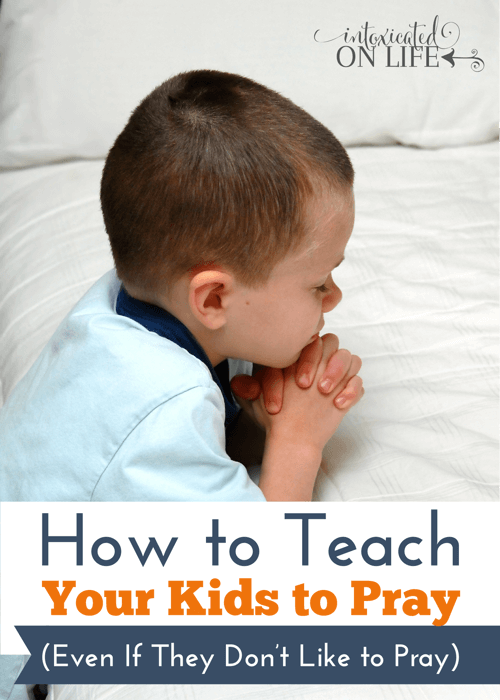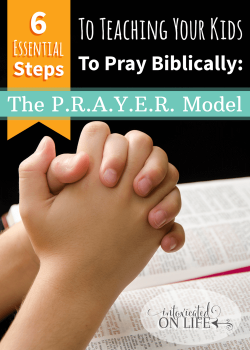The other day I noticed one of my kids getting restless while we were praying together, so I stopped praying and asked him, “What’s up?” He told me very honestly, “Prayer is boring!” Normally, I would be tempted to chew him out for being so irreverent, but something stopped me. In a moment of uncharacteristic sympathy, I saw things through his eyes: how many times had my mind wandered when others were praying?
I told him, “I understand exactly what you mean. It can be hard to enjoy prayer when you don’t even see the Person we’re talking to. It’s easy to get distracted or to think about other things that you think are more fun. I struggle with that, too. I want you to see why it is so powerful, so let’s spend the next several nights just talking about why prayer is so powerful and important.”
If there is one habit I want my kids to develop under our roof it is the discipline and joy of prayer. I want them to know that prayer is not boring, a waste of time, or a chore. I want them to learn to appreciate the power of prayer to draw us close to God and to bring about change in the world.
Below are some of ideas about how to do that.
.
Make Prayer a Habit at Home
One of the best ways to start a good habit is to tack the activity onto some other established routine. For instance, you may already do this when it comes to prayer and family meals—saying a blessing before you eat together. This is one easy way to make prayer a habit in the home.
Establish a prayer habit for a certain time of day: fix a time for you to pray with your kids adjacent to another established routine. For many parents, bedtime is the best time for this. For others it might be nap time or right after dinner. Choose a time that words best for your family.
A little more difficult to remember is the habit of “on the spot” prayers. The next time you hear your child get worried about something or talk about a topic that is distressing (someone is sick, a tragedy is happening somewhere in the world, etc.), stop everything and pray at that moment with your child. Get into a habit of uttering short prayers on the spot, showing your kids God is always ready to listen to us.
.
Give Them a Biblical Model: P.R.A.Y.E.R.
There are a lot of different prayer “outlines” out there that help us to remember how to pray, but you can’t improve on the perfect outline Jesus gave to us. The so-called Lord’s Prayer is the model we’ve been given by our Savior.
There are 6 petitions in the Lord’s Prayer, and since there are 6 letters in the word “prayer” I created an acronym for my kids to follow. Praise, Remake, Attitude, Yummy, Expose sin, and Rescue. You can read about the P.R.A.Y.E.R. Model here.
.
Give Them Freedom in Their Posture
Of all my children’s virtues, sitting still is not one of them. Even though I prefer to sit down when I pray, it is important that I not force my kids to take the same posture I do in prayer.
This is why it can be helpful to show kids from the Bible different postures of prayer. The goal of teaching these is to show them: (1) there is no “right” posture of prayer, (2) our body posture should be a reflection of our attitude in our hearts, and (3) there are ways to pray that don’t distract others.
- Sitting (Judges 20:26; 2 Samuel 7:18; 1 Chronicles 17:16; Acts 2:1-2) denotes an attitude of rest and learning
- Standing (1 Samuel 1:26; Nehemiah 9:5; Mark 11:25; Luke 18:10-13) denotes an attitude of attention, ready to receive instructions
- Kneeling (1 Kings 8:54; Ezra 9:5; Daniel 6:10; Ephesians 3:14) denotes an attitude of surrender
- Bowing with face to the ground (Genesis 17:3; Exodus 34:8; Job 1:20-21; Psalm 95:6; Matthew 26:38-39) denotes an attitude of humility and worship
- Laying down (Psalm 4:4-5; 63:6) denotes rest and meditation
- Hands outstretched (Exodus 17:11-14; 1 Kings 8:22; 1 Timothy 2:8) denotes an attitude of surrender and receptivity
- Staring up (John 11:41; 17:1) denotes trust and dependence
- Walking (2 Kings 4:35) denotes fervency
- Leaping for joy (Luke 6:23; 10:21) denotes great praise
Any one of these are proper postures of prayer, so open the Bible, show them these example, and show them with your own body how to do it. Ask them to choose a position that matches the attitude they want to have in their hearts.
.
Make Prayer Engaging: Eyes, Ears, and Hands
Find ways to get kids to engage with prayer by using all modes of learning: sight, sound, and touch. These three modalities relate to three learning styles. Visual-spacial learners think in holistic 3D images and big pictures. Auditory-sequential learners think in words and learn in a sequential, step-by-step process. Tactile-kinesthetic learners take in information through physical sensations and they benefit from demonstration more than verbal explanation.
- Make it visual: Use visuals to show them what to pray for. Have a tack board with some scraps of paper nearby to encourage kids to write down prayer requests and tack them up. Cut out clips from recent newspaper or online articles to pray about and post them somewhere in the home. Make a photo board of friends and family members to remember to pray for them.
- Make it auditory: Use music when you pray. Find good prayer songs that you can play, read the lyrics beforehand and talk about them, then sing the song together.
- Make it tactile: When praying, pass around a globe or a globe ball and when the ball comes to them, have them pick a country to pray for. Make a “prayer cube”—this is a paper cube with something to pray for on each side of the cube—and have kids take turns rolling and praying.
Show Them Prayer “Works”
Our children should approach prayer learning that we believe it really matters—God draws close to us in prayer and He answers us.
Consider making a prayer journal where you can write down specific prayers you prayed with your kids, the date you prayed those prayers, and any answers to prayer. When prayers are answered, show your kids that you are taking note of the answer.
When prayer feels like a chore, pull out the prayer journal and remind kids about the answers to prayer.
.
Become a Mom or Dad of Prayer
I want to become the kind of dad who prays often enough my kids catch me in the act—the way the prophet Daniel was caught on his knees (Daniel 6:11). I want to be the kind of father who shows my kids that prayer is enjoyable. When my kids think of me, I don’t want them to think of me as the guy who was always looking at his iPhone, always on his computer, or always watching TV: I want to be the guy they saw on his knees or with a Bible in his lap.
One of the best ways I’ve learned to pray is by reading about prayer from some of the church’s finest teachers:
- Answers to Prayer, by George Müller –George Müller is a hero of mine. His orphanage cared for more than 10,000 orphans in his lifetime. His life is a testimony to the power of God in prayer. This book is full of stories that will inspire you to pray with faith in God’s ability to provide. ($14.99)
- The Classic Collection on Prayer, E.M. Bounds – Bounds was a Methodist minister who wrote several books, mostly about prayer. Most of his writings were published only after his death, and this collection has inspired millions to live lives of persistent, constant, faithful prayer. ($18.99)
- Absolute Surrender, Andrew Murray – Murray was a Dutch Reformed minister in South Africa who authored hundreds of books. Absolute Surrender is based on a series of sermons preached by Murray that has since become a classic devotional for Christian readers. ($13.99)
- Fellowship of the Burning Heart and Mornings with Tozer, A.W. Tozer – These two collections represent some of the best writings and sermons of A.W. Tozer, who was a prolific author and preacher. J.I. Packer says of him, “Through all of Tozer’s books and articles there shines a passion for God that puts our shallowness to shame. Reading him is like drinking at an oasis in the desert.” ($13.99 and $13.49)











Great tips, thank you! We make sure to let our kids pray at dinner and not correct anything they say, make sure they know it’s about sharing their heart!
Thanks, Virginia!
Its one of my aim for 2020 to tech my children how to pray and to feel the power of praying
Wonderful tips! One thing that my son did was create his own little prayer area in his room, with projects from school, etc. It’s a great visual reminder!
Sounds like a great idea!
Thank you for this comprehensive and practical guide to praying with your children. It is one of the best I have read on the subject. I particularly liked the biblical study of postures while praying – it is so freeing for children to know that there is no “right” way to approach God in prayer. I can add another great book to your list: Praying the Names of God by Ann Spangler. I will definitely be sharing this article with parents. Thank you and God bless.
Thanks, Laura!
great tips! With seven kids from 16-2 can’t wait to try the P.R.A.Y.E.R model!
This is wonderful, Luke! Thank you so much. I think that praying for our children and teaching them to pray are more important than we realize. Pinning this to my prayer board. Thanks, again!
This was great, not only for children but for new Christians. We have to remember that there are not only children in the body but children in the spirit. I loved the clarity and the insight of routine in this writing. It is so important that the routine and practice is in place, even when we don’t feel like it. Connection with God and building our relationship with him is the main part. Thank you for sharing this with us.
You’re welcome, Gale. Habits can be a powerful thing because they will carry us through the dry times in life.
My little guy could recite the lords prayer by age 2 believe it or not.
Parents often sell their kids short when it comes to memorization. Our son was memorizing Psalm 1 at age 2. It is important for parents to remember that even when kids are delayed verbally, they are still memorizing.
Its a great idea will try it out